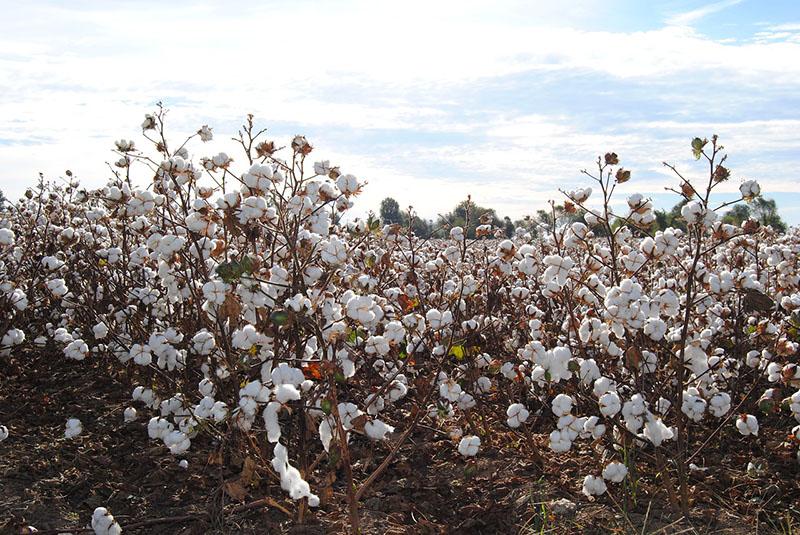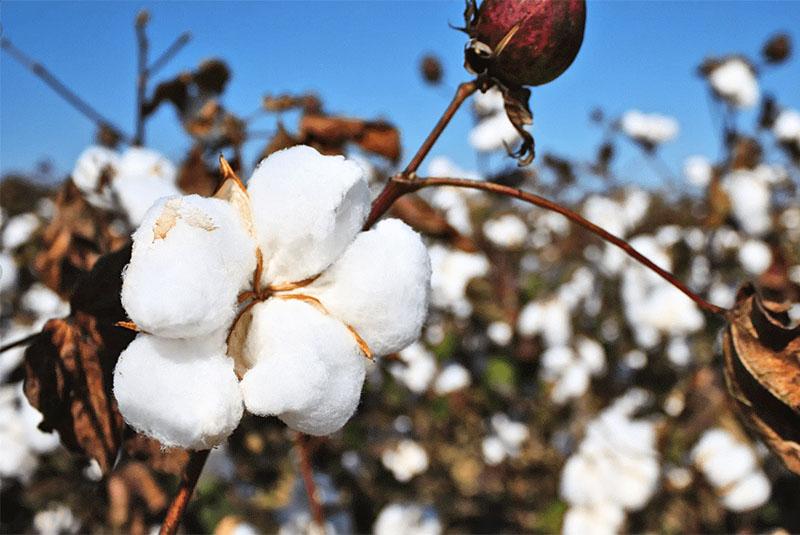Is it possible to grow cotton at their summer cottage
 Cotton is a thermophilic plant that is most commonly grown in regions with subtropical or tropical climates. But growing cotton is also possible on a personal plot, if the farmer or summer resident strictly adheres to important agrotechnical requirements and nuances.
Cotton is a thermophilic plant that is most commonly grown in regions with subtropical or tropical climates. But growing cotton is also possible on a personal plot, if the farmer or summer resident strictly adheres to important agrotechnical requirements and nuances.
What does cotton look like

What does cotton look like:
- The plant has a rod-type root system. The roots can reach up to 2.5-3.5 m deep into the soil.
- Stems are strong, branched, up to 1.6-2.1 m high.
- The leaves are arranged on petioles and are alternately attached to the stem. The shape is lobed, on each leaf plate there are 4-5 lobes that look like maple.
- The flowers are scarlet, snow-white or yellow. Each flower has 4-6 petals.
- After flowering is completed, unusual fruits are formed, which look like a round or oblong "box" containing seeds.
 After the cotton seeds are fully ripe, the capsules crack - inside them you can see a white fibrous mass, consisting of long and short hairs. This is cotton.
After the cotton seeds are fully ripe, the capsules crack - inside them you can see a white fibrous mass, consisting of long and short hairs. This is cotton.
On one bush there are up to 180-200 boxes of cotton. After ripening, up to 8-10 cotton seeds can be obtained from each.
Growing cotton - basic rules
 There are several agronomic requirements to be considered when growing cotton. This is the correct choice of the site and soil for its sowing, the timing, the required moisture level and lighting.
There are several agronomic requirements to be considered when growing cotton. This is the correct choice of the site and soil for its sowing, the timing, the required moisture level and lighting.
Primary requirements:
- Before planting cotton, it is very important to consider that with late planting, cotton bolls ripen only by November. Early sowing dates are considered optimal, no later than March.
- Cotton is a thermophilic plant, so it is very demanding on temperature. Seeds begin to germinate at + 11 ° С, at + 2 ° С the plant dies. The optimum temperature for growing it is from +26 to + 29 ° С.
- A well-developed root system ensures the plant is highly resistant to drought. It continues to grow, but the yield of cotton is significantly reduced, so the crop needs regular moisture.
- Cotton plants need uniform, diffused sunlight.
- For growing cotton, it is best to choose areas with saline, alkaline-boggy and serozem soils.
 Regardless of where the cotton is grown and on what soil, it is necessary to take into account the high demands of agricultural crops on nutrients. For full development and high yields, it needs a sufficient amount of phosphorus, potassium and nitrogen.
Regardless of where the cotton is grown and on what soil, it is necessary to take into account the high demands of agricultural crops on nutrients. For full development and high yields, it needs a sufficient amount of phosphorus, potassium and nitrogen.
Features of crop rotation

When growing cotton, it is necessary to take into account the peculiarities of crop rotation in the selected area, because the yield of agricultural crops depends on this. The best "predecessor" for cotton is alfalfa.
 Alfalfa plantations enrich the soil with nitrogen and stimulate the accumulation of humus, improving the drainage quality of the soil. As the experience of many farmers shows, growing cotton in the plots after alfalfa increases yields by 40-50%, while maintaining high soil fertility for up to 3 years.
Alfalfa plantations enrich the soil with nitrogen and stimulate the accumulation of humus, improving the drainage quality of the soil. As the experience of many farmers shows, growing cotton in the plots after alfalfa increases yields by 40-50%, while maintaining high soil fertility for up to 3 years.
In addition to alfalfa, legumes, corn, sugar beet and crops.
Soil preparation
 The growth and yield of cotton depends on how well the soil is prepared on the site.
The growth and yield of cotton depends on how well the soil is prepared on the site.
Basic rules of preparation:
- After harvesting alfalfa, the soil is peeled with a plow. The deepening should be no more than 6-7 cm - this will help remove seeds and weeds.
- The soil is plowed with a two-tier plow to a depth of 35-40 cm. With a large number of weeds, herbicides are simultaneously applied.
- Saline soils are re-loosened with a plow or cultivator.
- Rotted manure is introduced into soft soil, after which the site is plowed again.
- The soil is fertilized with complex mineral dressings containing potassium, phosphorus and nitrogen.
Nitrophoska or granular superphosphate, which are applied in a proportion of 100 kg per 1 hectare of land, are well suited as soil fertilization.
Seed preparation
 Before growing cotton from seeds, they must be properly prepared. Mechanical and chemical preparation is used. In the first case, it is necessary to partially or completely remove the padding on the seeds, in the second - etching with vapors of hydrochloric or sulfuric acid.
Before growing cotton from seeds, they must be properly prepared. Mechanical and chemical preparation is used. In the first case, it is necessary to partially or completely remove the padding on the seeds, in the second - etching with vapors of hydrochloric or sulfuric acid.
 After that, the seed should be left in the open air for 20-30 days. Then they are disinfected with copper sulfate, bleach or fentiuram.
After that, the seed should be left in the open air for 20-30 days. Then they are disinfected with copper sulfate, bleach or fentiuram.
Immediately before planting, cover the seeds with water and leave to soak for 9-12 hours.
Planting cotton
 Cotton seeds can germinate after sowing only if the soil temperature is at least + 10 ° C. There is no point in sowing a crop in frozen soil - the seeds will simply die.
Cotton seeds can germinate after sowing only if the soil temperature is at least + 10 ° C. There is no point in sowing a crop in frozen soil - the seeds will simply die.
Cultivation of cotton is carried out both by seedlings and by direct sowing into open soil. Germination technique:
- you can start growing seedlings in the second half of January or early February;
- plant the soaked and prepared seeds in a small flower pot or container;
- deepen the seed into the ground by 1-2 cm;
- cover the container with a layer of plastic wrap or glass;
- place the flowerpot in a warm and well-lit place;
- after 2-4 days, the first shoots appear, which need to be systematically moistened;
- when the sprouts reach 10-12 cm in height, transplant them in separate flower pots;
- when the soil warms up enough, transplant the seedlings into open beds.
When sowing directly into open soil, a distance of at least 55-65 cm should be left between the rows.In each hole, place 3-4 seeds, deepening them by 3-5 cm.If the soil is meadow or marsh, it is enough to deepen the seeds by 2-3 cm.
Cotton care
 As cotton grows, it needs regular grooming. The leading role in the care of agricultural crops is assigned to its regular and abundant moisture. You can water the plant in any way - both with a watering can and by a drip method.
As cotton grows, it needs regular grooming. The leading role in the care of agricultural crops is assigned to its regular and abundant moisture. You can water the plant in any way - both with a watering can and by a drip method.
Young shoots are watered twice - after the formation of 4-6 true leaves and 20 days later, before the beginning of the budding stage. This will ensure that the plant takes root quickly.
During flowering and fruiting, cotton requires the maximum amount of moisture. It is necessary to water the crop often, the average rate is about 650-750 liters per 1 ha of plantings. The last moistening is carried out 7-10 days before the fall of the cotton leaves.
Mulching and cultivation

Cultivation of the soil must be carried out three times during the growing season of cotton:
- The first is carried out when young shoots are formed - its depth is 9-11 cm.
- The second cultivation is just before the first wetting of the sprouts.
- The third time the soil is cultivated only after it is sufficiently dry.
Mulching is an important part of cotton care. For this, it is best to use organic matter - straw or rotted manure.Cotton should not be mulched with chopped grass, as it creates favorable conditions for the reproduction of insect pests.
Cotton feeding
 When fertilizing a crop, it is imperative to take into account the climatic features and the type of soil in the area. Immediately before sowing seeds, the soil is fertilized with superphosphate. After that, the second feeding is carried out during the formation of real leaves and flower buds. For this, phosphorus and potash fertilizers are used.
When fertilizing a crop, it is imperative to take into account the climatic features and the type of soil in the area. Immediately before sowing seeds, the soil is fertilized with superphosphate. After that, the second feeding is carried out during the formation of real leaves and flower buds. For this, phosphorus and potash fertilizers are used.
 At the first application of fertilizers, it is important to maintain a distance of 17-20 cm from the row, at the second - 23-26 cm. Timely fertilizing supports the development of the culture, increases the number of flower buds and increases the yield of the agricultural crop.
At the first application of fertilizers, it is important to maintain a distance of 17-20 cm from the row, at the second - 23-26 cm. Timely fertilizing supports the development of the culture, increases the number of flower buds and increases the yield of the agricultural crop.
Cotton is one of the most important crops, the cultivation of which is associated with long and painstaking work. Cotton produces a high yield only with strict adherence to a wide range of agrotechnical measures and careful care.